
A Krannert Art Museum exhibition features Japanese black ink and watercolor paintings by Shozo Sato, including landscapes of the American West. Contemporary work by artists using traditional Japanese techniques and aesthetics has not been well-studied by art historians.
Shozo Sato, "Fury of the Pacific," 1994. Blue tone ink, standard in, and silver pigment on sized, pre-mounted paper. Courtesy of the artist.
Photo by Chris Brown
CHAMPAIGN, Ill. - A Krannert Art Museum exhibition features paintings by Shozo Sato, the founder of Japan House and an emeritus professor of theatre and of art at the University of Illinois Urbana-Champaign, that explore landscapes of the United States, floral motifs and memories of postwar Japan.
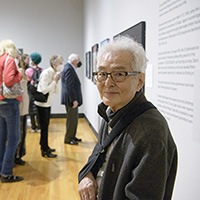
Shozo Sato attends opening night of "The Ink Wash Paintings of Shozo Sato" at Krannert Art Museum, 2023.
Photo by Della Perrone
In examining 20th and 21st century work by an artist who immigrated to the U.S., embracing Japanese traditions and aesthetics at a time when "West was considered best," "The Ink Wash Paintings of Shozo Sato" focuses on an area that has not been well-studied by art historians, exhibition curator Maureen Warren said.
An artist-in-residence at Krannert Center for the Performing Arts for more than 20 years, Sato is a master of kabuki theater, calligraphy, ikebana flower arranging and tea ceremony, as well as painting.
"Shozo Sato is beloved on campus and internationally. But because his painting was a private practice, just for himself, it's not been explored," Warren said.
Suibokuga, a type of Japanese black ink painting, is a more than 1,000-year-old tradition emphasizing expressive lines that capture the essence of a subject, rather than its literal appearance, she said. While most of Sato's artwork in the exhibition is within that tradition, his formal arts education in post-World War II Japan embraced Western styles. At that time, many Japanese artists abandoned traditional Japanese painting for Western media, such as oil painting, as well as abstraction and conceptual art, Warren said.
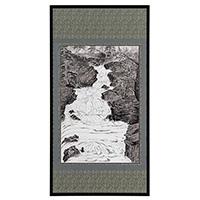
Sato's painting of a waterfall in Rocky Mountain National Park - with the water cascading over rocks portrayed using minimal lines indicating the movement of the water - illustrates the Japanese use of negative space in a painting. By leaving broad swatches open, viewers can imagine the force of the water, exhibition curator Maureen Warren said.
Shozo Sato, "Mountain Cascades," 1985. Blue tone and standard ink on paper. Courtesy of the artist.
Photo by Chris Brown
The exhibition includes three oil paintings Sato made while a student, including an abstract painting and a self-portrait, reflecting the kind of work being taught at Japanese universities at the time. When Sato arrived at the U. of I. in 1964 as a visiting artist, his colleagues urged him to adopt black ink painting so his work would not compete with their color paintings, Warren said.
Many of Sato's paintings depict landscapes conveying both nature's beauty and tranquility and its power and ferocity. The painted screens and landscapes "testify to Sato's life as a student of the elements," said Kevin Hamilton, the dean of the College of Fine and Applied Arts and professor of new media.
"These are not only pictures of water, sky, moon, petals. In Sato's hands, ink and watercolor move as analogies and metaphors for these things. They don't just stand in for the subjects they depict but help us understand them in analogous ways," Hamilton said.
During a sabbatical year in 1984, Sato traveled throughout the West and Southwest painting the quintessential American landscapes, a subject with a long, multimedia tradition in the U.S. and one familiar to international audiences through Hollywood Westerns. The paintings portray American places but include both style and subject matter that are traditionally Japanese, including rock formations and pine trees, the latter symbolizing resilience in Japan, Warren said.
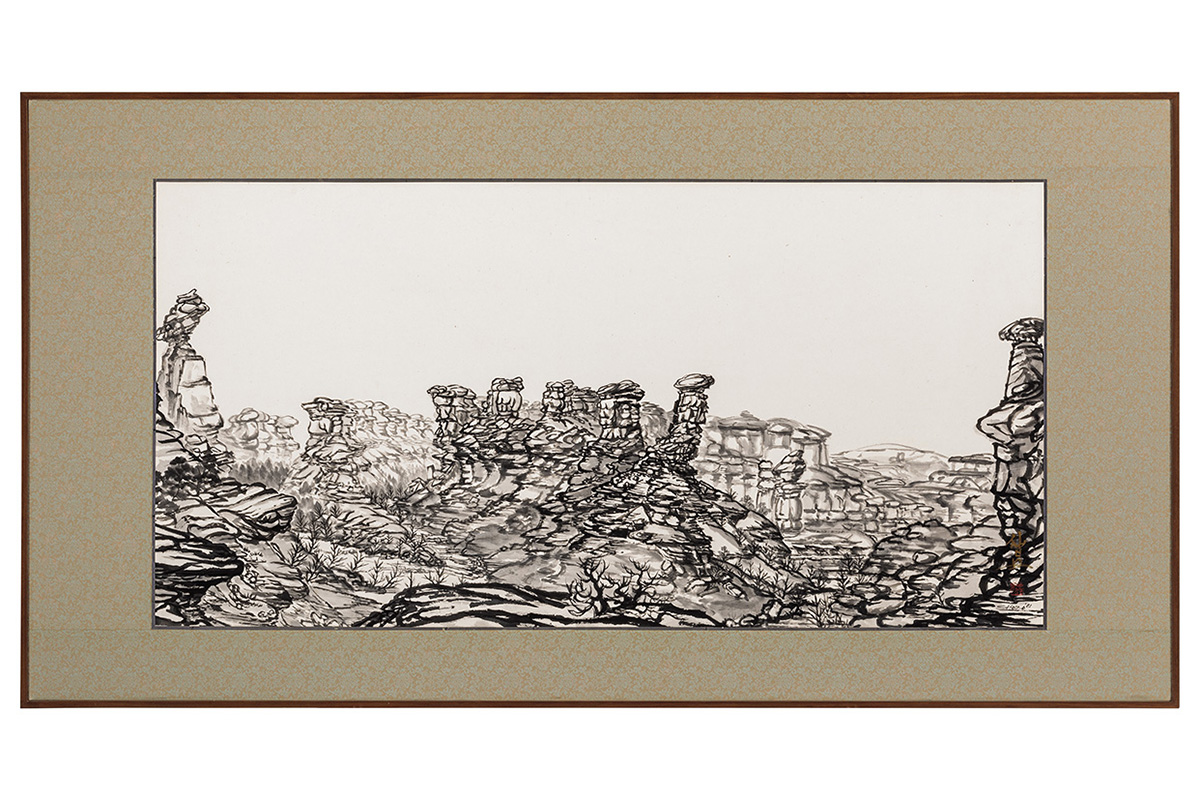
Shozo Sato," A Thousand Towers," 1984. Standard ink on paper. Courtesy of the artist.
Photo by Chris Brown
In Japanese tradition, brushes are used in specific ways for particular kinds of marks, but Sato used innovative forms of brushwork in "Fury of the Pacific," a painting he made after watching a pine tree thrashing in the wind as a hurricane-force storm hit Northern California's coast.
"He's entranced with this incredibly powerful demonstration of nature's might, and this pine's ability to withstand it. He said he fully identified with the pine tree in that moment," Warren said.
To create an image of waves hitting the rocks and throwing spray into the air, Sato smashed ink against the paper and then used a hair dryer to force the paint up to portray the spray.
"Innovation and black ink painting are not things that typically go together. This really stands apart," Warren said.
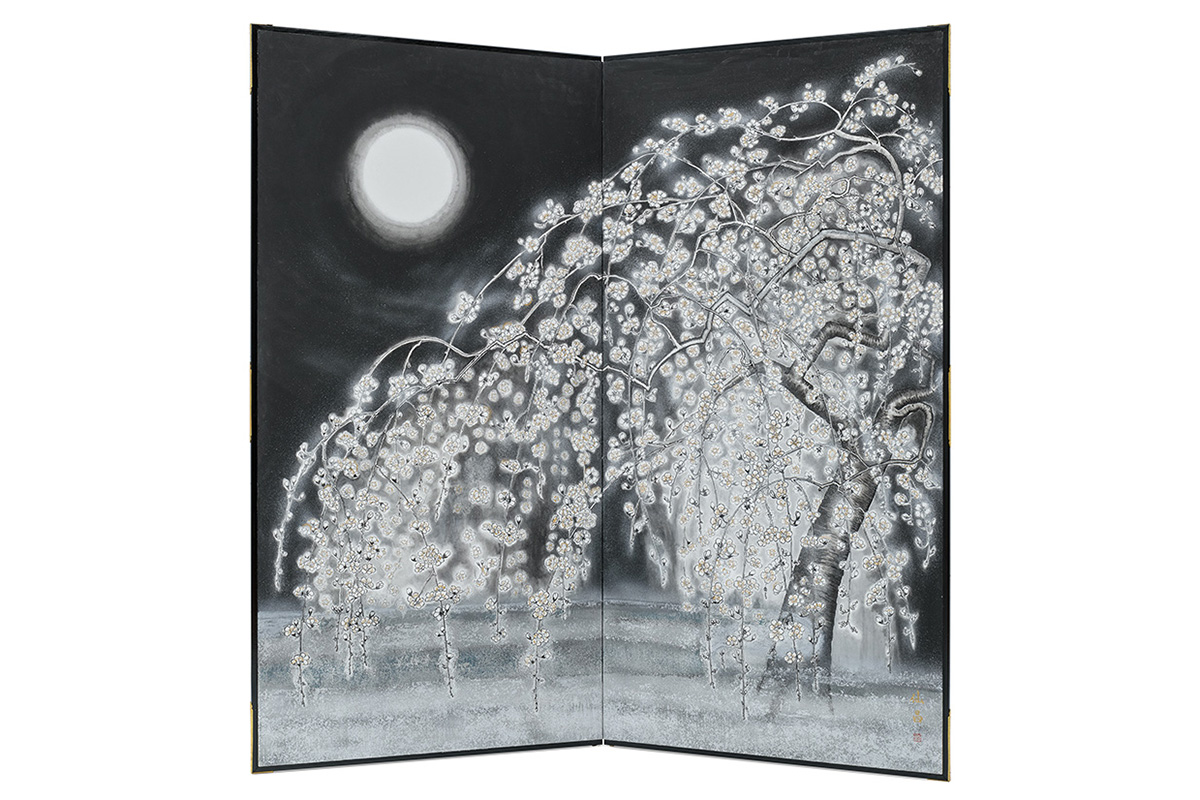
Shozo Sato, "Weeping Plum," 1990s. Folding screen with standard ink, 24 karat gold. Courtesy of the artist.
Photo by Chris Brown
The exhibition includes several painted screens, including a pair with paintings of flowering plum trees. One shows a plum tree bursting with white blossoms that glow in the moonlight. The ethereal image features detailed depictions of the five-petaled flowers and an abstract luminescent quality indicating the moonlight, Warren said.
The other painting takes a more minimalist approach in depicting a plum tree twisted with age but still putting forth colorful blossoms. Sato painted the tree as a self-portrait, and it represents the concept of wabi sabi - resilience in the face of difficulties and acceptance of the imperfection of all things, Warren said.
One wall of the gallery features paintings unlike the rest. In the past two years, Sato painted four watercolors depicting the horrors of war he saw as a child - the firebombing of his hometown of Osaka and the aftermath of the atomic bombing of Hiroshima.
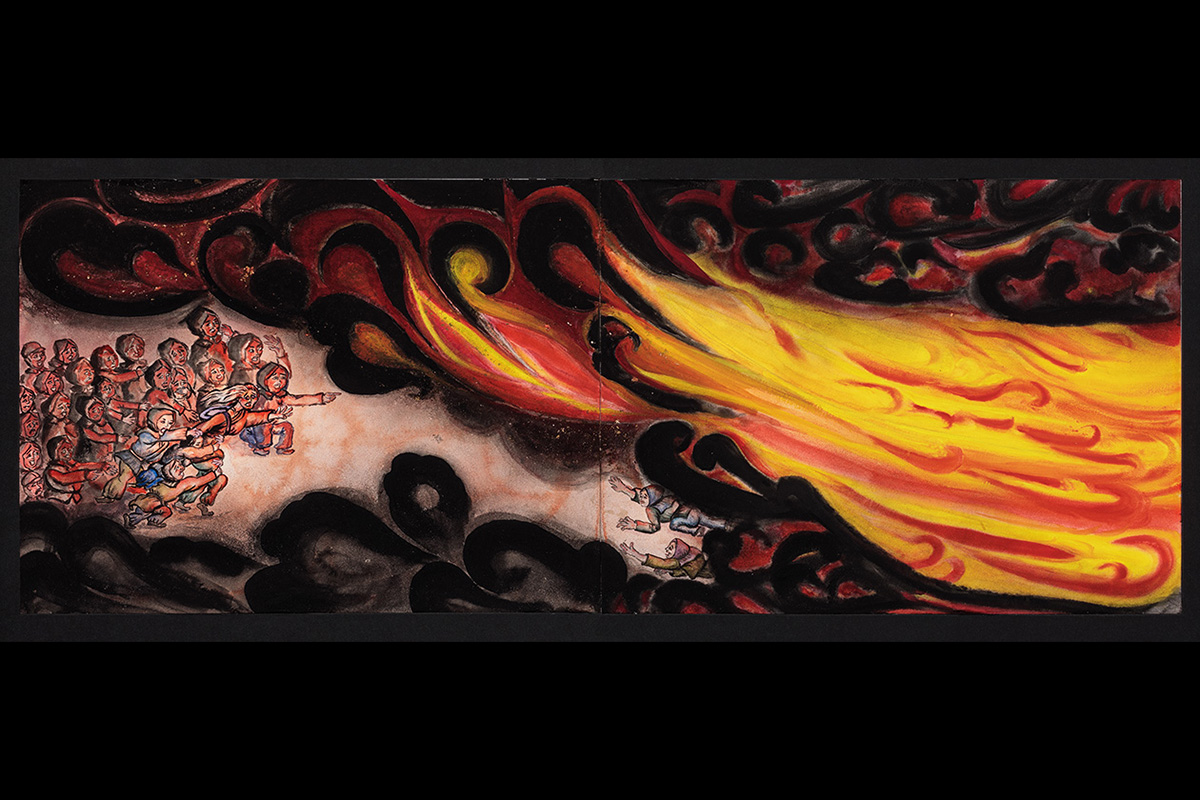
Shozo Sato, "Osaka Firebombing, City Burns," 2021. Watercolor on paper. Courtesy of the artist.
Photo by Chris Brown
Sato and his family crawled out of the fire that consumed Osaka's wood-timbered buildings. His painting shows a massive plume of fire and black smoke, with a crowd of people nearby who have narrowly escaped. One woman lost her baby as she fled the fire, and she's being held back from rushing into the inferno.
The other paintings show smoking pillars left after the firebombing; the twisted steel beams of a building in Hiroshima, leaning away from the direction of the blast; and Sato coming face to face with a charred body in Hiroshima.
Hamilton, who co-wrote a book on the U.S. Air Force film studio that photographed America's nuclear tests, found the most striking image to be a small detail in one of the Hiroshima paintings - a figure sitting on stone steps as the blast consumes the building behind them.
"I cannot see this image without thinking of Yoshito Matsushige's famous photograph of one individual's nuclear 'shadow' burned into just such steps. In the photograph, we can see where a person was sitting there at the instant of the blast - their body is now gone, but the steps retained the silhouette of their posture - just as Sato has depicted it. Sato has returned this unnamed person to the stair, daring to imagine the horrible moment of loss," Hamilton said.
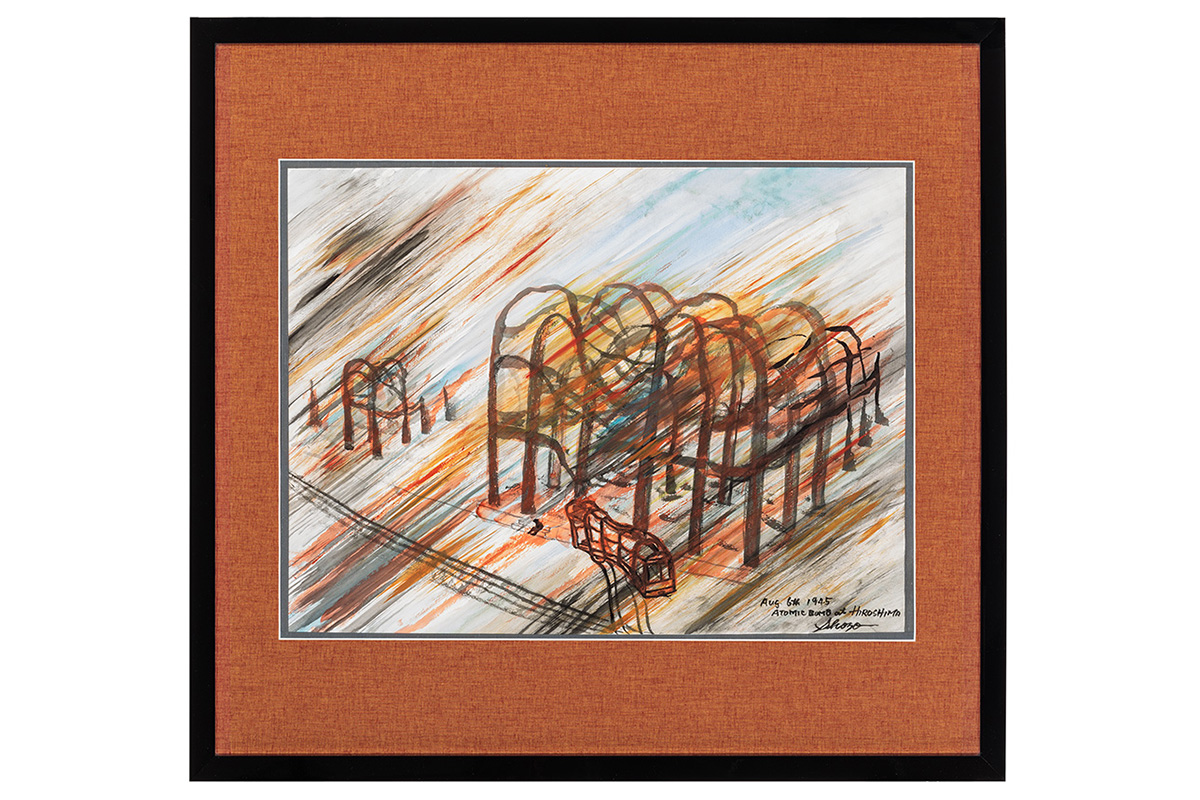
Shozo Sato, "Endurance," 2021. Watercolor on paper. Courtesy of the artist.
Photo by Chris Brown
Sato's paintings document the horrors for people who have not witnessed such devastation firsthand. The trauma of the events has stayed with Sato for a lifetime and led him to devote his artwork to conveying the preciousness of life and cultivating peace, Warren said.
"The Ink Wash Paintings of Shozo Sato" is supported by a gift from Joyce Chelburg and co-sponsored by Japan House at Illinois. The exhibition is on view at Krannert Art Museum through Dec. 22.






